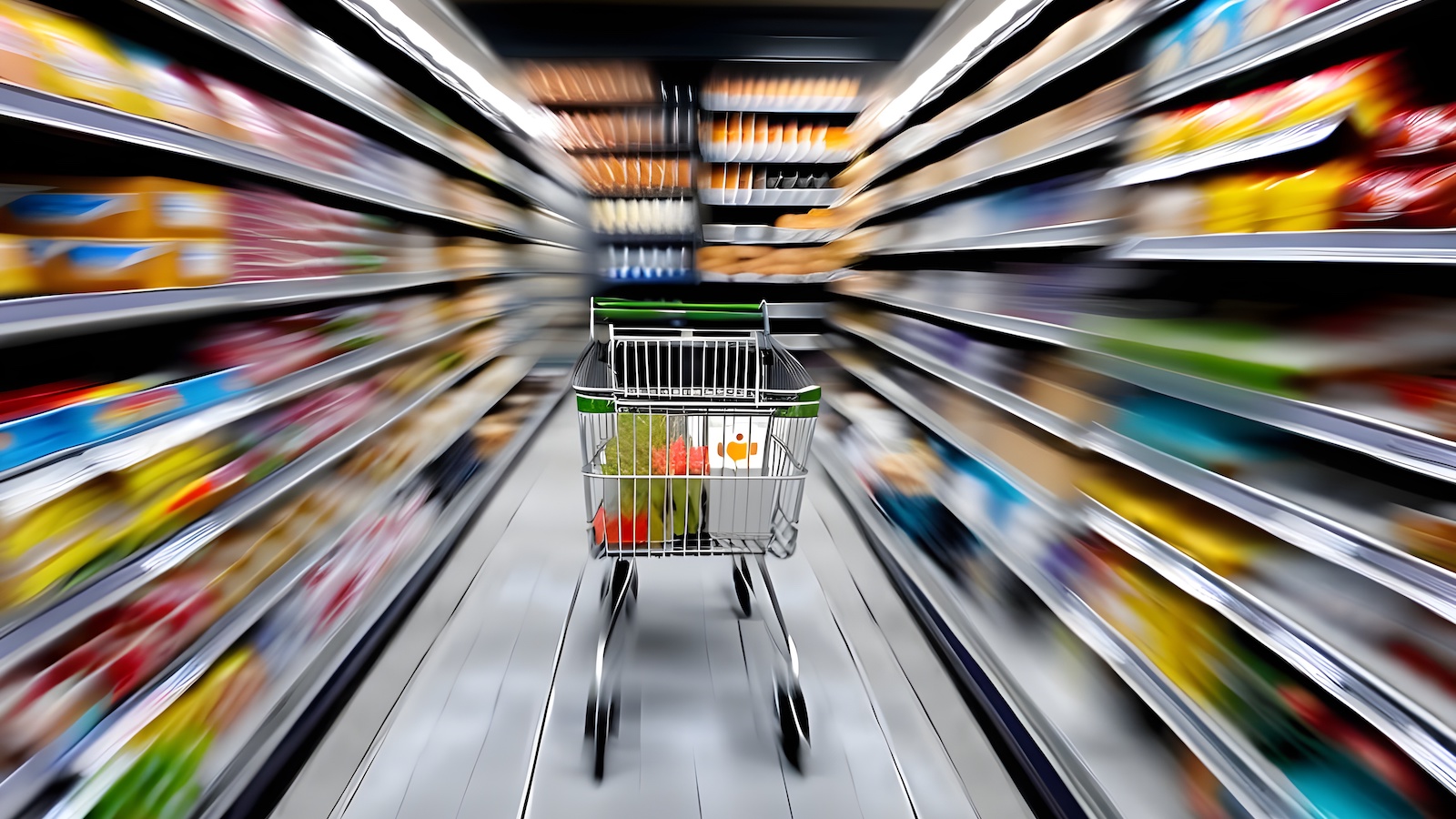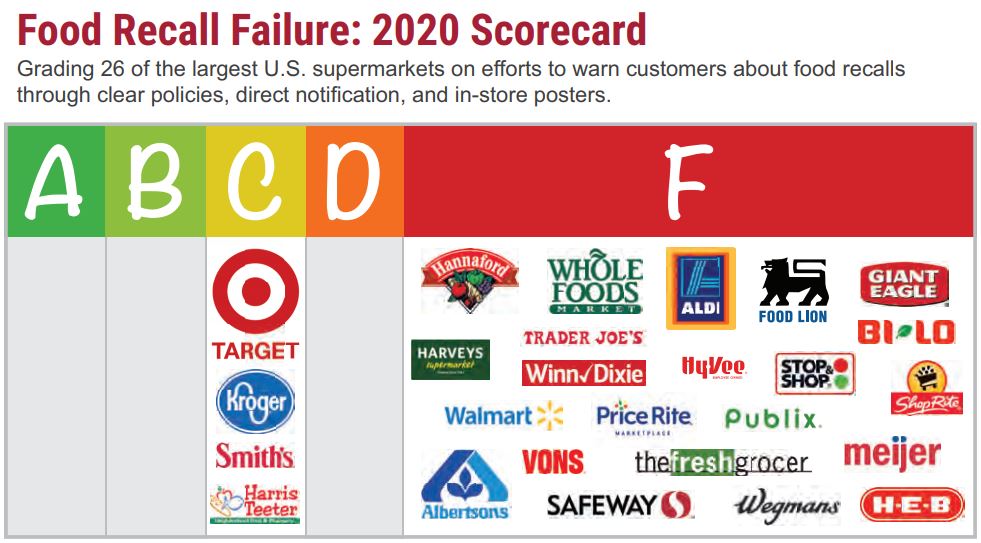
Food Recall Failure
Will your supermarket warn you about hazardous food?
Our research found the majority of grocery stores fail to warn the public about hazardous food recalls. While they collect significant information about Americans shopping habits to sell us more food, they aren't doing enough to use that information to protect the public health.
Downloads
The Center for Disease Control (CDC) estimates that 48 million Americans contract a food borne illness yearly with 128,000 people hospitalized and 3,000 dead as a result of these illnesses.
The food safety system uses two lines of defense to help prevent this threat. First a series of inspections and enforcement measures identify hazardous products before they make it to store shelves and Americans’ plates. Second, when a foodborne pathogen or other threats are still sold for consumption, the recall system attempts to remove the food from store shelves as quickly as possible and alerts consumers about the hazard. While not all illnesses are connected to a source, removing contaminated food from the market helps protect the public.
A myriad of actions could improve both lines of defense, but this report focuses on the second–and specifically efforts to notify the public of recalls.
A successful recall system aims to notify everyone who delivers, serves or purchases poisoned food. Effective communication about recalls is more important than ever to combat foodborne illness. Between 2013-2019, the most hazardous meat and poultry recalls increased 85% while recalls overseen by FDA such as produce and processed food has decreased by 8.4%. Whether it’s Salmonella in beef, or E. coli in flour, communication with consumers has clearly been an issue because of the number of cases where consumers continue to get sick after a recall is issued.
Despite this trend, and regular foodborne illness outbreaks, the current food safety system focuses heavily on getting recalled food off of store shelves quickly through a well-defined process followed by regulatory agencies, manufacturers and retailers for removing products. It is the last audience, the individual consumer, who is often left unaware because the recall system requires either proactive action to find alerts or hearing about a recall through media coverage. This can leave contaminated food in pantries, refrigerators and freezers for days or months after a recall.
Stores can play a key role in customer notification as they are access points in the food safety system that consumers most regularly and frequently interact with. And often, customers return to the same store again and again so understanding that stores notification policies are critical.
U.S. PIRG Education Fund attempted to survey the 26 of the largest grocery stores in the United States to determine the efficacy of their policies and practices notifying consumers about food recalls. In late August of 2019, we mailed a detailed survey to the head of food safety about stores standard practices on recall notification including their overall policies on recalls, in-store notification, and direct customer notification programs. For more than a month afterwards, our researchers attempted to obtain responses through emails and phone calls. Our effort attempted to contact the individual in charge of food safety, customer service departments, individual stores and other departments at each grocery store chain.
Unfortunately, most stores declined to answer the survey–and the few respondents only answered a handful of questions. This response is insufficient. Consumers have a right to know about food recalls to protect their health from dangerous pathogens, chunks of metal, and unlabeled allergens. With stores unwilling to share information about their notification policies with the public, U.S. PIRG Education Fund researchers did what any concerned consumer might if they had significant amounts of free time: a comprehensive review of all publicly available information about store recall policies by examining company websites, terms of service, and privacy policies. The scorecard evaluates three different areas of recall notification: store policies, in-store customer notification, and direct customer notification.

Our research found that publicly available information on recalls is woefully inadequate:
- Only four stores – Target, Kroger, Harris Teeter, and Smith’s – received a passing grade by providing adequate information about their recall notification policies to the public.
- 84 percent of grocery store chains failed to provide any public description of their process for notifying customers about recalls. This critical failure leaves consumers to seek out this information and risk inconsistent implementation by individual stores.
- More than half (58%) of surveyed grocery store chains report some program to directly notify consumers about recalls through email or phone. For seven of the fifteen stores that disclose a direct notification program, we were unable to find out when the program is activated, how customers participate, or what information is included in the notifications–limiting it’s potential effectiveness.
- No store provided information online about where recall notices are located in stores. Notices may be placed at customer service desks, checkout counters, store shelves or elsewhere in the store.
Customers shouldn’t have to go on a scavenger hunt to find out if food they recently purchased was recalled.Most people shop frequently at a single store, so knowledge of how that store conducts in-store notification would allow consumers to regularly check for product recalls.
Grocery stores are in a unique position to keep shoppers safe by effectively informing shoppers about food recalled due to a variety of hazards, filling gaps in the nation’s recall system. Through loyalty programs and purchase histories, stores have unique information about consumers that should allow them to provide targeted alerts to customers about recalled products. Stores can see sales of products drop after recalls and may receive some blame for failing to notify consumers. But, proactively warning customers they may have purchased recalled food is more than a critical mechanism to protect public health–it could help inoculate the grocery store from consumer outrage.
Until customers can easily find information on recall notification programs many people will remain in the dark, putting their health at risk.
Recommendations
Protecting public health from contaminated food is a top priority of grocery stores, food safety regulators, and consumer groups. To ensure food recalls reach the people who need to know about the potential hazards most, we recommend the following policies are implemented for all Class 1 and Class 2 recalls.
Any recall notification to customers through in-store postings or direct notification should include the name of the product, a picture, the reason for recall, the Universal Product Code (UPC) and instructions for how consumers should handle the product.
Grocery Stores
- Post the food recall notification process on their website, and make it easy to find.
- Signs for Class 1 and Class 2 recalls should be posted at the cash register and on the store shelf where the product would normally appear for at least 2 weeks for perishable food and for at least 1 month for frozen foods. Use the information collected through loyalty programs or purchase histories to directly alert customers of recalled products within 48 hours of a recall. Alerts should be sent using the method of communication that is most prompt and most likely to be seen by customers.
Policy
- The FDA and USDA should require that stores make their recall notification policies available to the public on their website and upon request.
- The FDA and USDA should require that stores post signs about Class 1 recalls at the cash register and on the store shelf where the product would normally appear in the store for at least 2 weeks for perishable food and for at least 1 month for frozen foods.
- The FDA and USDA should require stores to create direct customer notification programs that alert consumers of recalled products within 48 hours of a recall.
Consumer
- Sign up for recall alerts on the FDA website (https://www.fda.gov/safety/recalls-market-withdrawals-safety-alerts) and USDA website (https://www.fsis.usda.gov/wps/portal/fsis/home).
- Follow FDA and USDA social media accounts for updated information about recalls.
- Ask the customer service desk at their local grocery store for information about how they can be notified about recalls for food they purchase.
- Ask the customer service desk at their local store where recall notices are posted in the store. This will allow consumers to proactively follow recalls when they make return trips to their local grocery store.
Topics
Find Out More


Safe At Home in 2024?

5 steps you can take to protect your privacy now
